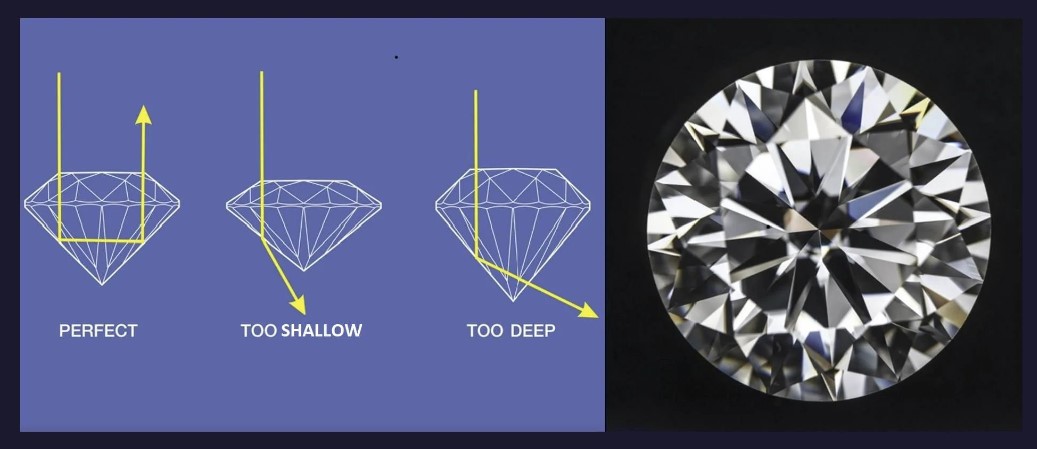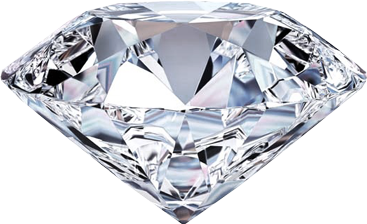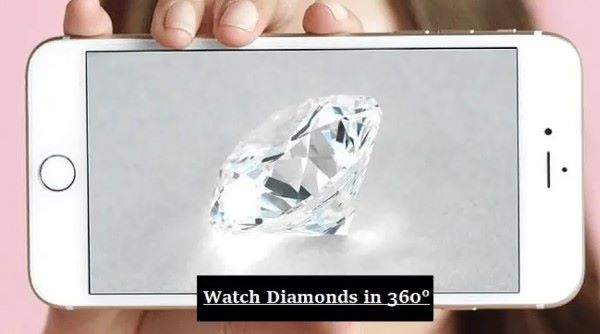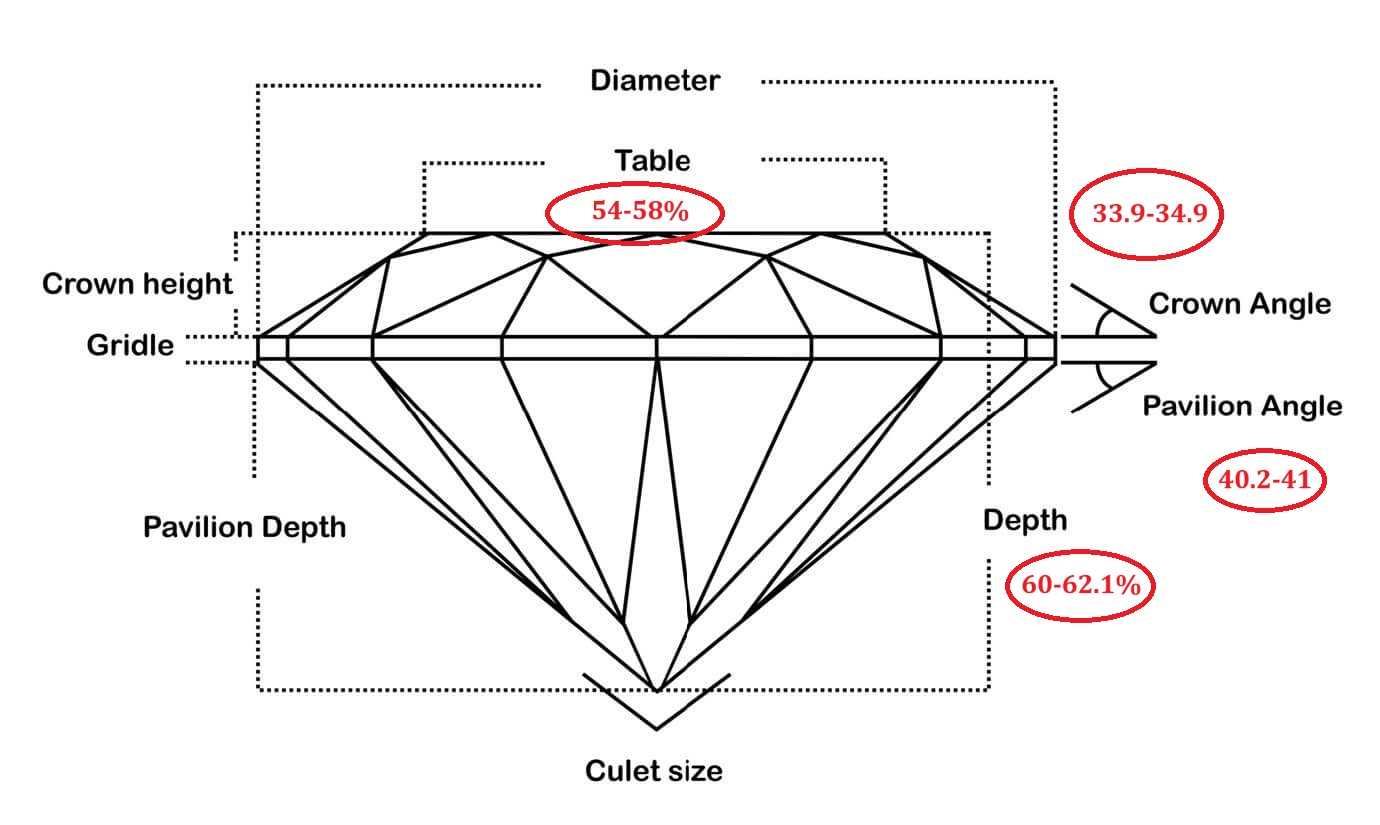What is Diamond Depth and Table? | Ideal Size & Percentages
What is Diamond Depth and Table? | Ideal Size & Percentages
Posted by Sharif Khan on 2nd Aug 2022
Diamond Depth and Table

The percentage at which a diamond's depth and table are cut represents two of the most pivotal elements in evaluating the cut quality of a diamond. The charts presented below offer comprehensive insights into the ideal depths and table percentages corresponding to each diamond shape. Moreover, we strongly advise referring to our detailed guide for each specific shape, as it provides in-depth and comprehensive insights.
- Review the charts below carefully for ideal depth and table percentages.
- Check our guide for ideal cut proportions as well.
- Watch HD Videos of James Allen's True Heart Diamonds and Astor Ideal Cuts by Blue Nile.
4Cs Overview
When shopping for a diamond, consider the following factors before narrowing down your choice to the perfect stone. These factors are commonly referred to as the 4Cs of diamonds by experts: cut, color, clarity, and carat weight. Each of these aspects influences the visual appeal and price of a diamond.
Diamonds are measured in carats, where one carat is equivalent to 0.2 grams or 0.007 ounces. Consequently, diamonds with higher carat weights are more expensive than those with lower weights, assuming all other factors remain consistent.
In addition to carat weight, diamonds are available in a variety of color hues. When it comes to DIAMOND COLOR, a general rule of pricing applies: the more colorless a diamond appears, the higher its price tends to be. However, there's an exception to this rule for red and pink diamonds.
Clarity pertains to the number of visible INCLUSIONS or blemishes present in a diamond, affecting its appearance. This implies that diamonds with more imperfections tend to be less expensive than their flawless counterparts.
The final component of the 4Cs is the CUT. Contrary to common perception, the cut of a diamond is not synonymous with its shape. Instead, it encompasses a harmonious blend of the diamond's proportions, polish, and symmetry, influencing how this combination impacts the overall aesthetic appeal of the stone.
Diamond Depth
Among the 4Cs, the cut of a diamond tends to capture the most attention from shoppers. This prominence stems from the diamond's cut's profound impact on its overall appearance.
The diamond's cut influences the stone's appearance in three primary ways:
- Brilliance: This measures the brightness resulting from both reflected and refracted lights.
- Fire: It signifies how a diamond disperses light into distinct flashes of visible color.
- Scintillation: This refers to the sparkling effect exhibited by a diamond when it's in motion.
The depth of a diamond plays a pivotal role in determining its brilliance, fire, and scintillation. In this context, depth refers to the height of the stone measured from the culet to the table, usually in millimeters.
The culet of a diamond is the bottom tip, typically invisible to the naked eye due to its position. An ideal culet is often categorized as either "small" or "none." On the flip side, the table of a diamond pertains to its topmost facet and is considered the largest one.
As previously noted, the depth of a diamond significantly influences how light behaves within it, including reflections that reach the observer's eye. For instance, light moves swiftly through shallow diamond cuts before exiting through the pavilion without generating noteworthy reflections. Conversely, overly deep cuts can diminish sparkle, giving the impression of a smaller diamond. This underscores the significance of choosing a diamond with an optimal depth that permits the entry of ample light. The light should strike each pavilion facet at an angle that allows a substantial portion to return to the observer's eye. It's worth noting from the outset that the ideal depth varies based on the stone's shape and cut, often graded from Poor to Excellent.
Given the pivotal role of depth in shaping a diamond's visual appeal and light performance, this characteristic is typically documented in a diamond grading report. Within the report, you'll encounter two distinct measurements describing diamond depth.
The first measurement, expressed in millimeters, represents the overall height of the diamond, while the second measurement relates to its depth percentage.
Ideal Diamond Depth Percentages
To determine the depth percentage of a diamond, you need to divide the total height by the average diameter of the stone and then multiply the result by 100. For instance, if a diamond's average diameter is 10 millimeters and its total height measures 6 millimeters, the calculation for the depth percentage would be as follows:

> (Total Height/Average Diameter) x 100.
> Divide 6 by 10, which gives you 0.6 millimeters.
> Multiply 0.6 by 100, which gives you 60%.
The following are the ideal diamond depth ranges for popular diamond shapes:
| DIAMOND SHAPE | IDEAL DEPTH (%) |
| Asscher or Emerald cut diamonds | From 61 to 68 |
| Cushion cut diamonds | From 61 to 68 |
| Heart-shaped diamonds | From 56 to 62 |
| Marquise diamonds | From 58 to 62 |
| Oval cut diamonds | Less than 68 |
| Pear-shape diamonds | Less than 68 |
| Princess cut diamonds | From 68 to 75 |
| Radiant cut diamonds | Less than 67 |
| Round diamonds | From 59 to 62.6 |
As previously emphasized, the depth of a diamond plays a pivotal role in aiding buyers to select the finest gemstones. But how can you effectively utilize this critical factor while on the hunt for your dream gemstone?
To begin, it's essential to pinpoint the specific diamond cut that aligns with your preferences. For instance, if you're in pursuit of a round diamond, make a request to the seller for a selection of round diamonds that match the description of your desired gem. Following this, take the time to visually inspect these diamonds to ensure they possess the physical attributes you're seeking.
Out of the 4Cs, you'll likely discover that assessing the cut presents the greatest challenge. To secure the right diamond cut, it's advisable to acquire a diamond grading report from the seller. This report will contain valuable information. Focus your attention on the depth percentage assigned to your desired round diamond. Upon thorough examination, if you find that the depth percentage falls within the range of 59 to 62.6%, you can confidently affirm that the diamond has undergone impeccable cutting and faceting. Conversely, if the depth percentage deviates from this recommended range, it's an indication that the diamond may not have been well-faceted, potentially impacting its sparkle and brilliance.
Diamond Table
A diamond table serves as the flat, uppermost, square-shaped facet of a diamond and derives its name from its pivotal position within its structure.
The core purpose of a diamond table is to refract the rays of light that traverse the diamond, guiding them toward the various facets. Much like depth, the diamond table significantly influences a diamond's fire, brilliance, and scintillation, contingent upon how it manages the incoming light.
The dimensions of a diamond's table constitute one of the critical factors shaping its visual characteristics. There is a prevalent misconception that a larger diamond table inherently enhances its light-handling capabilities. However, the size of the diamond table doesn't invariably correlate with superior light management. Excessively large diamond tables might limit the space available for the upper facets to disperse light effectively. Conversely, if the table is excessively small, only minimal light can penetrate the diamond, diminishing its brilliance. Naturally, one might anticipate larger diamonds to exhibit proportionally larger table dimensions and elevated table percentages. Nonetheless, depending on the specifics of a diamond's cut and faceting, the table size might not always align with the overall stone proportions. In many instances, consumers find themselves making a trade-off between fire and brilliance as they decide on the appropriate table size for their diamonds.
Given the diversity in physical table sizes, jewelers often rely on table percentages rather than raw dimensions when grading diamonds. Consequently, diamond grading reports assign a grade to the table size, ranging from Poor to Excellent, while expressing the table percentages as numerical values.
Ideal Diamond Table Percentage
According to the American Gem Society, the ideal table percentage of a diamond should range between 52 and 62%. But, as you will soon know, those percentages come down to individual preferences. Also, an ideal table percentage depends on the overall size and shape of the stone.
A diamond table percentage is determined by dividing the table's overall width by that of the whole diamond and expressing the answer in percentage. For instance, if a diamond has a table width of 10 millimeters and a total width of 8 millimeters, you will arrive at the table percentage as follows:
Table Width/Total Width) x 100
10/8 = 0.8
0.8 x 100 = 80%
The table below illustrates the ideal diamond table ranges depending on the cut;
| DIAMOND SHAPE | IDEAL TABLE (%) |
| Asscher cut diamonds | 61 - 69 |
| Cushion cut diamonds | 61 - 67 |
| Emerald cut diamonds | 61 - 69 |
| Heart-shaped diamonds | 53 - 63 |
| Marquise shape diamonds | 53 - 63 |
| Oval diamonds | 53 - 63 |
| Pear-shaped diamonds | 53 - 63 |
| Princess cut diamonds | 67 - 72 |
| Radiant diamonds | 61 - 69 |
| Round diamonds | 53 - 58 |
From the table above, the numbers do not appear to vary significantly. However, such minor variances exponentially affect a diamond's overall brightness and appearance. Similar to a diamond's depth, understanding the ideal table percentage for a cut is invaluable when shopping for a diamond.
Choose the Perfect Depth and Table
Analyzing the diamond cut is often the most intricate among the 4Cs. Furthermore, comprehending the technical intricacies of a stone's facets might still be challenging, even if you can differentiate diamond shapes and cuts. These very challenges prompted the development of depth and table percentages.
First and foremost, ensure that any diamond you purchase comes with a grading report from a reputable diamond grading laboratory. Obtaining a grading report should pose no difficulties, particularly for diamonds certified by well-regarded grading labs such as the Gemological Institute of America and the American Gem Society. These reports commonly detail depth and table percentages. Before examining the depth and table measurements, take the time to understand the diamond's cut grade.
For instance, you might be deliberating between a "Super Ideal Make" diamond cut and one categorized as "Ideal Make." In a direct comparison, the diamond with a "Super Ideal Make" grade is superior. However, when considering two diamonds rated as "Super Ideal Make," you must delve into their depth and table percentages. The stone boasting a higher depth or table percentage within the ideal range will exhibit superior light performance.
One noteworthy advantage of the ideal depth and table percentages lies in their minimal impact on your budget. Since these values are expressed as percentages, they remain consistent regardless of your diamond's weight, color, or clarity. Consequently, a diamond weighing 0.5 carats could possess depth or table percentages like a 100-carat diamond. Under equivalent circumstances, these two stones will showcase similar light-handling properties.
Final Thoughts
We strongly advise practicing due diligence when selecting depth and table measurements, as these represent the two primary facets of a diamond's cut that significantly impact its light performance. Collectively, a diamond's depth and table exert influence over its brilliance, fire, scintillation, and overall luster. Put simply, they dictate the level of sparkle your diamond radiates. Given that aesthetics reign supreme when it comes to jewelry shopping, it's imperative not to overlook this crucial step.
Furthermore, another compelling rationale for meticulously choosing the appropriate depth and table lies in their role in determining the price of a diamond. It's important to remember that jewelers often incorporate these seemingly minute details into their diamond pricing strategies. You might observe that two seemingly identical stones bear different price tags due to depth and table disparities.
While the diamond's depth and table measurements serve as valuable tools for narrowing down your ideal choices, it's prudent also to consider other quality parameters. Above all, remember that your personal tastes and preferences hold the utmost significance. If a diamond has an exceptional appeal in your eyes, all other factors assume a secondary role.





